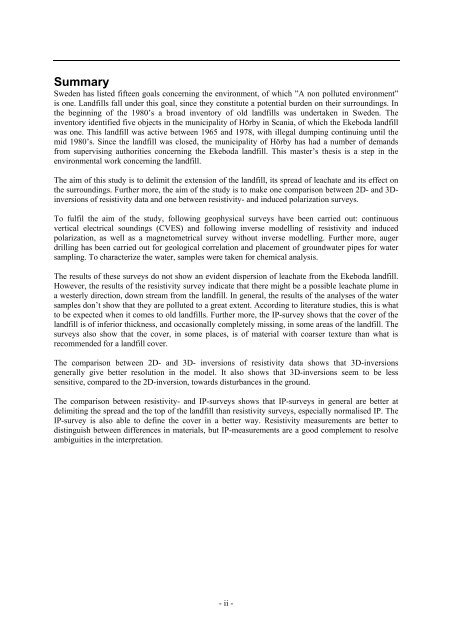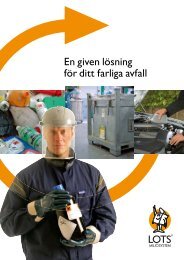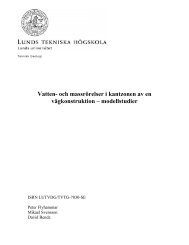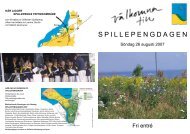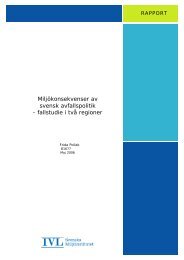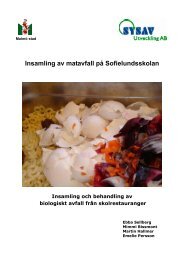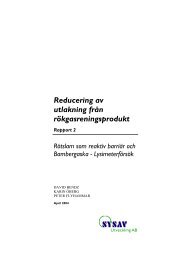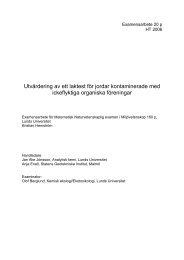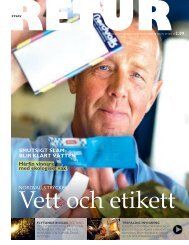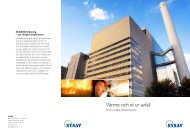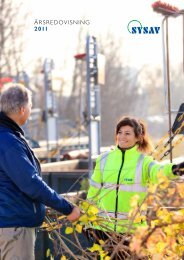utbredning, lakvattenspridning och påverkan på omgivning - Sysav
utbredning, lakvattenspridning och påverkan på omgivning - Sysav
utbredning, lakvattenspridning och påverkan på omgivning - Sysav
You also want an ePaper? Increase the reach of your titles
YUMPU automatically turns print PDFs into web optimized ePapers that Google loves.
Summary<br />
Sweden has listed fifteen goals concerning the environment, of which ”A non polluted environment”<br />
is one. Landfills fall under this goal, since they constitute a potential burden on their surroundings. In<br />
the beginning of the 1980’s a broad inventory of old landfills was undertaken in Sweden. The<br />
inventory identified five objects in the municipality of Hörby in Scania, of which the Ekeboda landfill<br />
was one. This landfill was active between 1965 and 1978, with illegal dumping continuing until the<br />
mid 1980’s. Since the landfill was closed, the municipality of Hörby has had a number of demands<br />
from supervising authorities concerning the Ekeboda landfill. This master’s thesis is a step in the<br />
environmental work concerning the landfill.<br />
The aim of this study is to delimit the extension of the landfill, its spread of leachate and its effect on<br />
the surroundings. Further more, the aim of the study is to make one comparison between 2D- and 3D-<br />
inversions of resistivity data and one between resistivity- and induced polarization surveys.<br />
To fulfil the aim of the study, following geophysical surveys have been carried out: continuous<br />
vertical electrical soundings (CVES) and following inverse modelling of resistivity and induced<br />
polarization, as well as a magnetometrical survey without inverse modelling. Further more, auger<br />
drilling has been carried out for geological correlation and placement of groundwater pipes for water<br />
sampling. To characterize the water, samples were taken for chemical analysis.<br />
The results of these surveys do not show an evident dispersion of leachate from the Ekeboda landfill.<br />
However, the results of the resistivity survey indicate that there might be a possible leachate plume in<br />
a westerly direction, down stream from the landfill. In general, the results of the analyses of the water<br />
samples don’t show that they are polluted to a great extent. According to literature studies, this is what<br />
to be expected when it comes to old landfills. Further more, the IP-survey shows that the cover of the<br />
landfill is of inferior thickness, and occasionally completely missing, in some areas of the landfill. The<br />
surveys also show that the cover, in some places, is of material with coarser texture than what is<br />
recommended for a landfill cover.<br />
The comparison between 2D- and 3D- inversions of resistivity data shows that 3D-inversions<br />
generally give better resolution in the model. It also shows that 3D-inversions seem to be less<br />
sensitive, compared to the 2D-inversion, towards disturbances in the ground.<br />
The comparison between resistivity- and IP-surveys shows that IP-surveys in general are better at<br />
delimiting the spread and the top of the landfill than resistivity surveys, especially normalised IP. The<br />
IP-survey is also able to define the cover in a better way. Resistivity measurements are better to<br />
distinguish between differences in materials, but IP-measurements are a good complement to resolve<br />
ambiguities in the interpretation.<br />
- ii -


